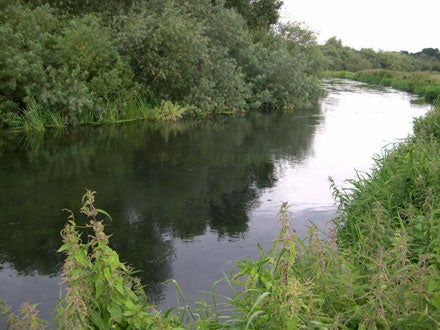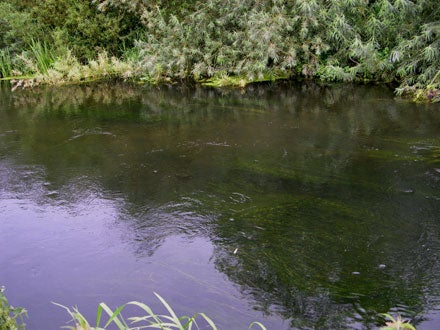| MARK WINTLE |
| Mark Wintle, an angler for thirty-five years, is on a quest to discover and bring to you the magic of fishing. Previously heavily involved with match fishing he now fishes for the sheer fun of it. With an open and enquiring mind, each week Mark will bring to you articles on fishing different rivers, different methods and what makes rivers, and occasionally stillwaters, tick. Add to this a mixed bag of articles on catching big fish; tackle design, angling politics and a few surprises. Are you stuck in a rut fishing the same swim every week? Do you dare to try something different and see a whole new world of angling open up? Yes? Then read Mark Wintle’s regular column. |
| CRAFTY AVON CHUB Or, if you don’t at first succeed, try, try again Having spent three solid weeks fishing on Throop for big chub in late July, I thought that it would make a change to spend a day on the Avon, away from the crowds. My approach would be to take it as it comes, to try to find some fish before deciding where to fish rather than simply fishing blind. I was also keen to find out whether the pellet approach could be made to work on the Avon. There is much less pressure on the middle Avon around Ringwood, especially far from the access points. Would the chub and barbel recognise pellets as food? There was only one way to find out, and that was to give it a try.   The first Saturday in August was dull and damp; light rain was forecast. By the time I got to the area I had in mind I was sweating heavily, especially after paddling across the sodden fields. When I got to the river it was much weedier than I thought it might be. On the Somerley estate the weed is not cut at all. The result in this area is a high water level, lush fields, and more importantly tricky fishing. Fortunately, I knew where to head, and dumped my gear near the top of a very fast, shallow glide. The bank side vegetation is lush on the low banks but this gave me valuable cover as I scanned the swim for signs of life. Eventually, I spotted two good chub right at the tail of swim. As is the case on the Stour, it is a case of feeding the swim and giving it time to settle. It is amazing what fish start to appear when this done. This swim could easily be fed by hand at the head of the swim where fast shallow water dropped into slightly deeper water. I fed half a dozen big handfuls of pellets in various sizes from 3mm to 6mm. These dropped though a weedbed at the top of the run. There was a lot of weed, both at the head of the swim and through the length of the swim, and I wondered whether this would cause a problem in fishing it. There was also a lot of drifting weed coming down with current, mostly small bits big enough to catch the line, and also a few rafts that would drag in an unattended rod if I wasn’t careful. This is the reason I try to hold the rod when legering on the Avon. I tackled up a feeder rod with a feeder. I then got settled in so that I was sat below where I wanted to fish, casting upstream and across. The river is narrow here because of an island so it wasn’t a very long cast. I hoped that because there would be hardly any line in the water little of the drifting weed would catch the line.   Some hope! Though I could get the feeder to hold okay, I had constant problems with the drifting weed. The pellets being fed through the feeder were doing their job though, and by now there were at least three chub feeding hard on the gravel. These fish were highly active, constantly dropping back and then coming up the swim to feed. After an hour of this, and with the drizzly rain making life unpleasant, no bites, and frustration setting in, I broke down the rod. But where else to go? Yet, here I was with a swim full of feeding fish. Why move when it was surely just a case of finding a way of catching them? Perhaps float fishing would provide an answer. I set up a float rod with four pound line, 14 hook and a 7BB Drennan wire stem Avon. I like these floats in fast water; their stability and the fact that the wire stem cuts through the current well make them versatile floats for this type of fishing. I continued to feed the swim by hand, and fished a hookable pellet on the hook. It soon became apparent that the complex cross currents in the swim were going to make life difficult. There was a strong diagonal current underwater towards my own bank yet on the surface the swim appeared to flow in the right direction. By experimenting with overshotting the float, and discovering exactly where to cast I did manage to get most of the trots following a true path. The chub were less impressed. Apart from scattering and hightailing it to the tail of the swim every time I cast in, I could not get a bite, even when there did appear to be chub in the vicinity. Meanwhile, when left alone, the chub were feeding ever more voraciously, even standing on their heads to grub deeper in the gravel for the pellets. Once again I was on the verge of packing up. I’d even put the rod back in the holdall when again I stood and stared at the swim. There had to be a way. The chub were feeding harder than ever. I dug out the reel with four pound line and reassembled my feeder rod. I decided to link leger a Halibut pellet, again fishing upstream but this time holding the rod. I hoped to avoid some of the drifting weed and by positioning the rod carefully find the best position to miss the bulk of the drifting weed near my own bank. Holding the rod allowed me to touch leger which can be advantageous when fishing these big pellets for chub. After experimenting, I found that using a bait band threaded through a drilled pellet and looped back on itself offered the most secure way to attach the pellet. The bait band is tied to the hook.   What followed more than made up for the earlier frustrations. I had six or seven bites. What was strange was that when I detected a bite touch legering I struck instinctively yet I could never remember actually having a bite. Of those bites I hit five of them. One fish came adrift shortly after hooking. Of the four chub I landed, the first three were between three and four pounds, fine fish but nothing exceptional. The final one made the frustration worthwhile, a cracking fish of 5.5 that fought hard in the weed. After a while, although four or five chub continued feeding in the swim, no more bites were forthcoming (possibly because I’d already caught them?), and with no sign of barbel, I packed up, this time to actually leave the swim. There is no doubt that these chub recognised pellets as food. Catching them had much to do with the awkward geography of the swim, the crystal clear water, the abundant weed, and strong, complex currents (the fastest part was around 6mph). Despite the arguments for and against touch legering, in these circumstances it was deadly. This type of fishing, where you know the fish are present and feeding but frustratingly difficult to outwit, is often the most rewarding of all when you do finally figure it out. If at first you don’t succeed… |













